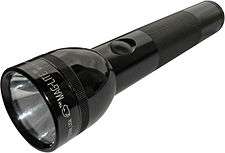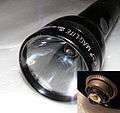Maglite

Maglite (also spelled Mag-Lite) is a brand of flashlight manufactured in the United States by Mag Instrument, Inc. located in Ontario, California, and founded by Anthony Maglica. It was introduced in 1979.[1][2] Constructed principally of anodized 6061 aluminum, they have a variable-focus beam. Maglites are produced in several colors such as black, silver, blue, red, green, purple, gold, and different finishes. Originally Maglite flashlights used krypton or xenon incandescent bulbs. Current models have LEDs, although the older models are still widely available.
Accessories include belt holsters, mounting brackets, colored and glass lenses, attachable fiber optics extensions, higher-powered incandescent bulbs, and LED conversion modules. The Maglite was an improvement over the Kel-Lite, after which the Maglite was patterned.[3]
Timeline
A list of the sizes of Mag Instrument flashlights, and the years they were released:
- 1979: D and C battery models are put on the market; targeted to the public safety and industrial sectors (the 7D, 5C, 6C, and 7C models are out of production)
- 1982: MagCharger: a larger more expensive model popular with public safety and emergency-services personnel. This light is much brighter than typical Maglites, and uses an incandescent Halogen bulb and a rechargeable NiCad or NiMH battery pack.
- 1984: Two AA cell batteries (Mini Maglite) Maglite's first personal size flashlight
- 1987: Two AAA cell batteries (Mini Maglite) A smaller version of the original Mini Maglite
- 1988: One AAA cell battery (Maglite Solitaire) Mag Instrument's key chain flashlight.
- 2006: Maglite LED Flashlight and Upgrade Module: 3-watt Luxeon III LED.[2]
- 2006: Mini Maglite LED 2AA.
- 2008: MagCharger: Upgraded Nickel/Metal Hydride (NiMH) battery pack increases charge time and second generation Halogen bulb increases light output.
- 2009: Next Generation Mag-LED Technology: Featuring a new Luxeon Rebel LED and extended battery life.
- 2010: Maglite XL100: offers a motion-controlled user interface using a built-in accelerometer
- 2010: Maglite XL50: This is a simpler version of the XL100, featuring three modes that can be activated with consecutive presses of the tailcap switch. The XL50 will have a lower retail price than the XL100.
- 2011: a variety of LED and rechargeable flashlights introduced.These include the ML100 and the rechargeable/C Cell LED ML125
- 2011: Maglite XL200: This is similar to the XL100 but offers higher lumen output.
- 2012: Mini Maglite AA Pro 215 Lumens and Mini Maglite AA Pro+ 245 Lumens. A further upgrade of the Maglite MagCharger called
- 2012: Maglite 2D pro 274 Lumens with a Cree XP-G rather than a Cree XP-E, increasing brightness while decreasing beam distance efficiency.
- 2012: Maglite Mag-Tac flashlight plain bezel, 310 Lumens, low mode at around 100 Lumens. First Maglite flashlight to use CR123A batteries. Tactical style designed with military input.
- 2012: Maglite Mag-Tac crowned bezel, 320 lumens. This model has no low mode for light output.
- 2012: the V4 was also released with a newly developed electronic switch enabling a Multi Mode operation and a slightly more powerful bulb producing an output of 245 Lumens.
- 2012: In August, Maglite announced several new models including an LED version of the Solitaire, a Mini Maglite LED 2 AAA and a new version of the 2D LED termed the 2D LED Pro promising a beam in excess of 200 Lumens.
- 2013: Maglite released an LED version of the MagCharger. Features a 680 lumen output and spot-to-flood beam with a quarter turn of the head. Claimed 4 hrs of battery life on a full charge at full power. Other specs are as the Incandescent Version.[4]
Models
| Model | Incandescent | LED |
|---|---|---|
| Solitaire | Maglite Solitaire | Maglite LED Solitaire |
| Mini Maglite | Mini Maglite 2-CELL AAA | Mini Maglite LED 2-CELL AAA |
| Mini Maglite 2-CELL AA Xenon | Mini Maglite LED 2-CELL AA | |
| Mini Maglite LED 3-CELL AA | ||
| Mini Maglite PRO LED 2-CELL AA | ||
| Mini Maglite PRO+ LED 2-CELL AA | ||
| Maglite XL | Maglite LED XL50 | |
| Maglite LED XL100 | ||
| Maglite LED XL200 | ||
| Maglite D | Maglite 2-CELL D | Maglite LED 2-CELL D |
| Maglite PRO LED 2-CELL D | ||
| Maglite 3-CELL D | Maglite LED 3-CELL D | |
| Maglite 4-CELL D | ||
| Maglite 5-CELL D | ||
| Maglite 6-CELL D | Maglite LED 6-CELL D | |
| Maglite 7-CELL D | ||
| Maglite C | Maglite 2-CELL C | Maglite ML100 LED 2-CELL C |
| Maglite 3-CELL C | Maglite ML100 LED 3-CELL C | |
| Maglite 4-CELL C | ||
| Rechargeable | MagCharger - NiMH/Halogen | MagCharger LED and ML125 |
| Maglite MAG-TAC | Maglite MAG-TAC LED 2-CELL CR123 |
Law enforcement use
Maglite flashlights have been known to be used as a ready substitute for a baton. In 2004, the Los Angeles Police Commission moved to use smaller flashlights, with Alan Skobin, the commission vice-president, stating that "This policy makes clear flashlights are for illumination and discourages their use as an impact tool. And it ensures officer safety as well as protects the public."[5] Security and police personnel often carry Maglite flashlights as they can be employed as a defensive weapon, especially at night or in dark locations. Police officers will often use Maglites during traffic stops or suspect confrontation, as the beam can disorient an attacker and the flashlight can be swung as a baton as a measure of last resort in self-defense.[6]
On March 30, 2007, the Los Angeles Police Department announced that they would be switching to a smaller, lighter LED flashlight that cannot be used as a baton, in response to a highly publicized incident where an officer was accused of using excessive force against a suspect by using a Maglite.[7]
Gallery
 Most Maglites have a spare bulb in the tailcap. LED lamps have a long life, and do not usually need to be replaced. Some LED Maglite models have a spare incandescent bulb.
Most Maglites have a spare bulb in the tailcap. LED lamps have a long life, and do not usually need to be replaced. Some LED Maglite models have a spare incandescent bulb. Closeup view of a 4D Maglite with the factory-installed Luxeon LED module. The inset shows the LED module with the reflector assembly removed.
Closeup view of a 4D Maglite with the factory-installed Luxeon LED module. The inset shows the LED module with the reflector assembly removed. The 2xAA Mini Maglite in four colors
The 2xAA Mini Maglite in four colors Mini Maglite and belt holster
Mini Maglite and belt holster
References
- ↑ Nick Freeth. Made in America: from Levis to Barbie to Google MBI Publishing Company, 2005 ISBN 0-7603-2270-8, pp.180-181
- 1 2 "Maglite Event Timeline". Maglite. Retrieved 27 December 2010.
- ↑ William Lidwell, Gerry Manacsa Deconstructing Product Design: Exploring the Form, Function, Usability, Sustainability, and Commercial Success of 100 Amazing Products Rockport Publishers, 2009 ISBN 1-59253-345-0, pp.116-117
- ↑ "Maglite MagCharger LED Flashlight System | Review". Flashlight University. 2013-11-12. Retrieved 2016-07-09.
- ↑ Winton, Richard (December 15, 2004). "Police Panel Endorses Limits on Flashlights". http://articles.latimes.com/2004/dec/15/local/me-poxcom15. LA Times. External link in
|website=(help) - ↑ "Tactical flashlights vs self-defense flashlights - Any difference?". Million Candle Power. Retrieved 27 March 2016.
- ↑ "LA police get flashlight that stuns, not strikes". The New Zealand Herald. 31 March 2007. Retrieved 2010-03-30.
External links
| Wikimedia Commons has media related to Maglite. |
- Official website
- Complete disassembly of a 2D Maglite flashlight with a xenon bulb
- Maglite's Tony Maglica: Torchbearer of the American Dream